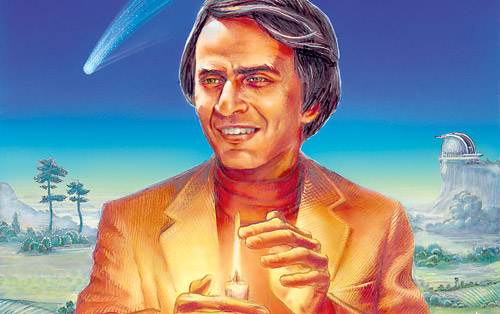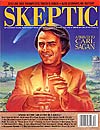December 20, 1996. As I was sitting in the Skeptics Society’s office this morning working on final edits of this issue and my forthcoming book, my partner Pat Linse came in. I bid her good morning and inquired if there was anything important happening that I needed to know. “Yes,” she said with an ashen look in her face. “Carl Sagan is dead.” The news came like a blow to the gut. Just last week I saw him on Nightline, telling Ted Koppel that the prospects for his future health were excellent. Just last month Carl and I had communicated by email about doing an interview for Skeptic magazine. And just like that he is gone.
How fleeting is our tenure on planet Earth, Sagan might have said. We must make the most of it. Carl certainly did. Born November 9, 1934, in New York City, he obtained a Ph.D. in astronomy and astrophysics from the University of Chicago in 1960. From 1962 to 1968, he worked at the Smithsonian Astrophysical Observatory. From 1972 to 1981 he was Associate Director of the Center for Radio Physics and Space Research at Cornell University. Up until his death he was David Duncan Professor of Astronomy and Space Science there. Throughout this time he worked closely with NASA and JPL on many space probes, and he co-founded and served as President of the Planetary Society. As if that wasn’t enough, Sagan won the Pulitzer Prize for his book The Dragons of Eden, following that up with such classic works as Broca’s Brain, The Cosmic Connection, Intelligent Life in the Universe, Shadows of Forgotten Ancestors, Pale Blue Dot, and The Demon-Haunted World. Sagan is best known to the general public as the writer and host of the most-watched documentary series in history, Cosmos, for his regular appearances on Johnny Carson’s Tonight Show, and for his column in Parade magazine.
Among Sagan’s plethora of awards were NASA’s Apollo Achievement Award, the John F. Kennedy Astronautics Award from the American Astronautical Society, the Masursky Award from the American Astronomical Society, the Konstantin Tsiolkovsky Medal from the Soviet Cosmonauts Federation, the 1981 Humanist of the Year Award from the American Humanist Association, and honorary degrees from 22 universities. The film version of his novel Contact, about the first communication between humans and an alien intelligence, is scheduled for release in the summer of 1997. It stars Jodie Foster and is directed by Robert Zemeckis, who did Back to the Future. What a full life it has been.
It was a gloomy day here at the office. As I write, Carl is on the television screen discussing the long historical chain from genes to brains to books, as Cosmos plays in the background — our own small tribute to one of the finest human beings of our age. Like so many others my life was deeply affected by Sagan. His book, The Dragons of Eden, got me thinking about the evolutionary aspects of human behavior when I was a graduate student in psychology, and provided material for a number of lectures in my introductory psychology course when I was a professor. Cosmos showed me how important the history of science is to our understanding of how science works and its impact on our culture.
Most significantly, in the Fall of 1987, Sagan delivered a lecture I attended in Pasadena, California, entitled “The Burden of Skepticism.” It came at a crossroads in my life when I was trying to find my intellectual moorings. After reminding us of the joys and responsibilities of science and skepticism, Sagan concluded:
If we teach school children the habit of being skeptical perhaps they will not restrict their skepticism to aspirin commercials and 35,000 year old channelers. Maybe they will start asking awkward questions about economic or social or political or religious institutions, and then where will we be? Skepticism is dangerous. In fact, it is the business of skepticism to be dangerous. That is exactly its function.
It is not only what Sagan said, but how he said it that signaled to me what I needed to do. His forceful presence, deliberate style (with that sonorous voice), carefully-chosen humor, and most of all his pure class radiated that night. I wanted to be a part of the business of skepticism and start asking awkward questions of any and all institutions and beliefs. It was a defining moment. I wanted to be a skeptic.
Immediately after the lecture I applied to the Claremont Graduate School, earned a Ph.D. in the history of science, and within six months of graduating in 1991 founded the Skeptics Society. In a way, the Society was born at that 1987 lecture, at which Carl stated what I think is the essential tension between skepticism and credulity, and serves as a beacon toward which we may steer whenever we lose our intellectual moorings.
It seems to me what is called for is an exquisite balance between two conflicting needs: the most skeptical scrutiny of all hypotheses that are served up to us and at the same time a great openness to new ideas. If you are only skeptical, then no new ideas make it through to you. You never learn anything new. You become a crotchety old person convinced that nonsense is ruling the world. (There is, of course, much data to support you.)
On the other hand, if you are open to the point of gullibility and have not an ounce of skeptical sense in you, then you cannot distinguish the useful ideas from the worthless ones. If all ideas have equal validity then you are lost, because then, it seems to me, no ideas have any validity at all.
No one is grieving today more than Carl’s family. But on another level we are all grieving because Sagan transcended self and science, reaching through the intellectual, cultural, and political boundaries to all peoples. To quote George Bailey’s guardian angel, Clarence Oddbody, from It’s a Wonderful Life: “Strange, isn’t it? Each man’s life touches so many other lives, and when he isn’t around he leaves an awful hole, doesn’t he?”
You see, Carl, you really had a wonderful life.
This article can be found in
volume 04 number 04
Carl Sagan Tribute
this issue includes: Can History Be Science?; Sulloway on Born to Rebel; Debunking Nostradamus; Critical Thinking About History; Left and Right Science; What Happened to N-Rays?…
BROWSE this issue >
ORDER this issue >
This article was published on September 25, 2009.

















Just finished the last tape of Cosmos. In episode VI Travelers Tales, 15 Minutes in, Carl talks about the Dutch and their wisdom concerning the pursuit of profit being detrimental to the Nation. This from the 17th Century no less. His sadness at the threat of nuclear war chilled me. His vision was broad and deep and I felt blessed to go along with this wonderful man on his journey.
Carl Sagan fue el primero que me hablo del cosmos del Universo…recuerdo que me amanecía para verlo junto a mi padre, pues en mi país hace algún tiempo daban los culturales a las 2am en ese tiempo tenia 10 años.
Gracias a él mi generación vio el firmamento con mucho asombro y una infinidad de preguntas y cuando hoy enseño a mis alumnos geoastronomía sobre los viajes espaciales, las muertes de las estrellas, los agujeros negros, la exploración de marte, de los grandes héroes olvidados de la humanidad como Jhojanes Kepler, Hipatia entre otros…me llega a la memoria su imagen…Gracias maestro por regalarme un poco de su ser y dejarme ver los rostros de asombro en cada uno de mis alumnos en especial los mas pequeños… hay veces creo que es el mismo rostro que yo he tenido de pequeño ahí con mi padre cuando nos amanecíamos para verlo… Gracias maestro, se que ahora es usted un guardián de la armonía de los mundos allá en el firmamento…
Gracias papa “Luis Alberto” por responderme pacientemente varias preguntas que he tenido de pequeño sobre esta hermosa serie, y espero también verlo algún día con mis propios hijos…
Gracias a ustedes dos grades hombres que influenciaron en mi vida…gracias.
I am unlucky that I came to know about Carl Sagan after he died, but I am very much lucky that I came to know about him before I die.
I agree that Sagan died much too young. He should have lived at least another 10-15 years.
To be a freethinker in this world, amidst a torrent of misguided and erroneous credulity, is to be in a way inexorably alone. Misgivings about the present and future constantly lingering just below the surface. Gnawing at what hope one may be capable of mustering in the face of adversity. To overcome this is to be no less than a giant among men.
Carl overcame this affliction of circumstance. He did so with resolve. Maintaining his integrity of character and his class. He was truly an inspiration. He was a man to be admired and emulated. Admired not only for his intellect, his eloquence, or diversity of skills, but his courage to be a candle in the dark for us all.
As an inspiration to myself
and countless others,
he is missed.
Beautifully put.
beatiful words, reminds me about carl sagan
I love to watch today’s cosmos. Carl was a very intelligent man. what God has.
I’m trying to make a custom t-shirt using this picture. Does anyone know where I can get a bigger version of this picture?
well ,surely the greatest free thinker of our age , how it all becomes clear , absolutly beutifull,
who needs to beleive in religons designed to restrict , when the truth is over poweringly awesome ..
I miss him i only saw one video with him in it “We are all connected” he was a genius. he thought me about how we are all connected and what cosmos is.
Carl Sagan really cared about the future of our race,He made a huge effort to explain to us in simple terms very complicated ideas.
Not only did he convey the laws of our universe to us but he tried to persuade us to look after our planet for future generations and made us believe that in the future we may well travel to other worlds.
I think he must surely be remembered as one of the greatest minds to have ever lived.
Thank you Carl.
Yes the Pale Blue Dot!!
With 70 Sextillion Stars and counting, how can we even utter the words, we are ALONE??
Thank you Carl, for openning our eyes!!
We all miss you.
A giant left the pale blue dot and will be missed. A man who helped me to think for myself.
Even though it was not his best work, “A Candle in the Darkness” got me thinking as an adult, about just how much we let fly without challenging it. As a child I was in awe of Cosmos, and recently I saw Cosmos again, and I was amazed at how much it stood the test of 30 years. I immediately purchased it for my nieces and nephews, as it so well connects with children. If it weren’t for Carl Sagan, I wouldn’t at least try to look at this world more critically.
Thanks a lot for your article. Carl Sagan also taught me to be skeptic. It has been a wonderful lesson to confront the entire life.I always will miss mister Sagan forever.